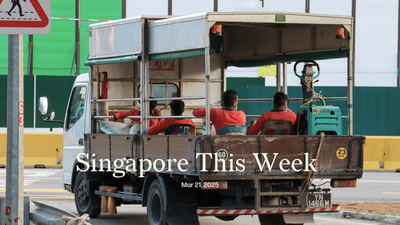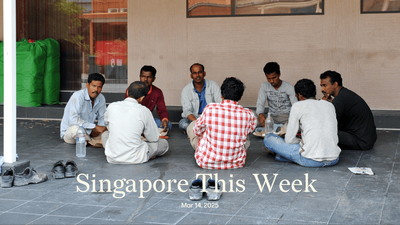Politics: A Myanmar arms dealer tries to leave Singapore with over half a million dollars in cash
On December 26th 2023, Kyaw Min Oo, Wai Sar Tun, and Win Myint, three Myanmar nationals, collectively tried to carry over half a million dollars of Kyaw’s money through Changi Airport without declaring it. The Singapore Police Force (SPF) caught them, and they were fined a total of S$20,000. In its statement on January 5th this year, SPF did not mention that Kyaw has been on numerous international sanction lists since 2022. These details were first reported by The Irrawaddy on January 8th, and then by The Straits Times (ST) on January 11th. “Kyaw Min Oo profits from the violence and suffering the military has inflicted on the people of Burma since the military coup,” said Brian E Nelson, under secretary of the US’s Treasury for Terrorism and Financial Intelligence, in its statement in 2022. Kyaw, ST said, was the director of five Singapore-registered companies that trade in helicopter and aircraft spare parts. He stepped down only in April 2022, more than a year after the military coup, and just months before the US treasury statement. Kyaw has since left Singapore voluntarily. According to Singapore law, he could have been fined up to S$50,000 and/or imprisoned for up to three years. It’s unclear why he was subject only to a paltry fine. It is abhorrent that arms traders use Singapore as a base, and breeze in and out so easily. In “Is Singapore being used to finance wars?”, Jom reported on the numerous allegations that Singapore is being used to finance the militaries of Myanmar, North Korea, and Russia. This money flows through the “Switzerland of the East”. We are all implicated. Much more must be done—by the government, by investigative reporters, and by ordinary citizens, who must make our voices heard.
Society: SPF’s powers grow, as it considers hiring officers from China, India, Myanmar and the Philippines
The law and home affairs ministries, led jointly by K Shanmugam, tabled a bill that would offer sweeping new powers of arrest, search and investigation to the SPF. If passed, officers will be able to conduct a search without a warrant when they have reason to believe that the relevant evidence is in the possession or power of a suspect of an arrestable offence. They will also be able to force accused persons to undergo forensic medical examinations (FME), such as blood samples, DNA and penile swabs, where it is relevant to the investigation of an offence that is reasonably suspected to have been committed. The bill also introduces a new Sentence for Enhanced Public Protection (SEPP), targeted at those who commit serious violent and sexual offences. Those sentenced to SEPP will be detained for a minimum term of five to 20 years, but will not be released automatically. The minister of home affairs will assess if they still pose a threat to the public. If so, they can be detained indefinitely, even for life, but with regular reviews of the aforementioned threat. While the bill is clearly targeted at the most abject of crimes, including sexual abuse of minors, there will undoubtedly be concerns about its impact on civil rights, particularly if there are cases involving false accusations. (Some protections are mentioned in the bill: “Safeguards will be put in place to ensure that FME are conducted appropriately, and that persons subject to FME are treated sensitively.”) Separately, Singapore’s recruitment of foreign auxiliary police officers (APOs), limited currently to Malaysia and Taiwan, may soon be expanded to China, India, the Philippines and Myanmar, said Shanmugam. The reason is that there aren’t enough Singaporeans willing to do this work. Malaysians and Taiwanese make up 32 percent of APOs, but even their numbers are dwindling. In 2019, Taiwanese media reported that their APOs want to quit because they have to work gruelling, 13.5 hour work days for a S$2,675 monthly salary. This is roughly half of Singapore’s median salary, and only three to four percent of Shanmugam’s pay. In law and order, as elsewhere in the country, extreme pay inequity is a major issue. Even as we equip some officers with greater powers, we should consider paying all more.
Society: New acute hospital model in the works
Singapore’s healthcare system has always combined elements of social protection and free-market choice. Partly given our rapidly ageing population—one in four citizens will be 65 or over by 2030—and associated costs, the Ministry of Health (MOH) has just proposed a not-for-profit (NFP) private acute hospital model. These hospitals will offer “appropriate and affordable” healthcare with “a stronger emphasis on cost efficiency and value”; focus on serving mainly Singapore residents; and provide some subsidised acute bed capacity. Profits will not be distributed to shareholders, but reinvested in the hospital and/or charitable and other non-profit activities. MOH, which says it needs to increase bed capacity in both public and private institutions, has invited private healthcare operators to participate in an industry consultation. Mount Alvernia Hospital is the only private NFP acute facility in Singapore, providing a combination of public healthcare affordability and private healthcare convenience. It also offers unique programmes like pastoral care when hospitalised, and community outreach activities to the vulnerable and disadvantaged, including subsidised medical and dental services. By prioritising accessibility, NFP hospitals can improve and uplift the communities that they service. But in the US, for instance, which relies heavily on “charity care”—nearly 60 percent of the more than 5,000 community hospitals are privately operated nonprofits (with massive tax breaks)—they’re also poorly regulated, ultimately hindering healthcare access. Human Rights Watch noted in a 2023 report: “Like wolves in sheep’s clothing, unscrupulous nonprofit hospitals can hide among their responsible peers, benefiting from their public perception and tax-status as charitable institutions while engaging in extractive and exploitative practices.” Many private NFP hospitals also enable abusive medical billing as well as aggressive debt collection practices; and, according to a 2022 investigation by The New York Times, have denied care to patients in debt, while prioritising the rich—giving preferential treatment to donors, trustees and their families. These are cautionary tales of what could go terribly wrong. The MOH consultation process and Singapore’s strong regulatory framework could feasibly discourage such virulent practices from infecting the healthcare system here. And perhaps by never forgetting that gold-plated tap.
Society: No kick
“It’s really heartbreaking to see culture and community constantly being ripped out of the heartlands,” said local rapper and music producer TheLionCityBoy. “You bury the heartland courts you will kill sports in Singapore. You can’t sell Passion Made Possible only when it’s convenient.” He was referring to the temporary closure of a street football court in Bedok, following complaints of court users urinating in the lift landing, dropping Milo powder around the void deck, screaming “unbear[ably]” late into the night and getting into heated altercations with residents. “You don’t live there, you’ll never know,” said Steven Low, a resident of Block 422 which faces the football court. “How will you feel when you can’t even do your work at all at home?” Many online bemoaned the closure, sharing nostalgic memories of the 40-year-old court. Football commentator Edwin Yeo also argued that the closure of such spaces directly impacts the local professional football scene, resulting in less new talent. The loss of such shared spaces is keenly felt by the whole community, not just footballers; the court was a common meeting point for Carousell sellers and buyers and a hang-out spot for youth all around the neighbourhood. On Tuesday, nominated member of Parliament Syed Harun Alhabsyi raised concerns about the closure in Parliament. “To close, barricade or block common spaces appears to suggest that there can be no room for compromise and that the redacted behaviour or activity is so abhorrent that there is no place for it at all,” he said. Muhammad Faishal Ibrahim, minister of state for national development, responded: “Some interventions in public housing estates, like the closure of amenities, may seem harsh. But they are necessary…” Has Singapore’s long-standing love of bans and blunt solutions obscured other possibilities besides closure? Some residents of Block 422 suggested the use of an electronic lock to prevent usage of the court later in the day, while others believe teaching court users the importance of respect and consideration for others is key. “Let them play,” said Appavoo Ramasamy Sumathi, who has lived in Block 422 for 30 years. “Where else will the children go?”
History weekly by Faris Joraimi
The Third National Climate Change Study portends a hotter, drier future on this island. Anecdotally, both my parents really believe it’s a lot warmer now than when they were growing up in the 1970s, in kampungs in eastern Singapore. Statistically, the middle of that decade, said the Meteorological Service, is when Singapore’s average temperatures began to steadily warm. It was, after all, when the effects of climate change began to be felt globally, and when our rapid urbanisation began. We lost once-widespread features of our landscape that tempered the tropical heat: namely, natural forest cover and traditional dwellings. Given our addiction to air-conditioned living and years of developmentalist propaganda, it’s probably harder for many to imagine that kampung homes were both habitable and comfortable. A piece by Kontinentalist last year described some reasons why. The use of natural materials (earth, timber and straw), large windows and openings, an open interior layout as well as elevation on stilts all maximised natural ventilation and promoted passive cooling. These features were both functional and aesthetic, as artisans produced elaborate carvings of vegetal and abstract forms on ventilation panels and windows. Vernacular construction also consumes less energy than its “modern” counterparts. According to urbanist Imran Tajudeen, entire districts—such as Geylang Serai—once comprised hundreds of such raised-floor timber houses, well-built according to plans and designs submitted to and approved by the colonial authorities. Miniature scale models were made prior to construction. Contrary to popular misconceptions that kampung homes were haphazardly assembled huts or unsanitary “slums”, they represented centuries of intergenerational knowledge transfer, and a diverse array of architectural styles from across the Malay Archipelago. They were a technology of living with environmental realities. Calls for “kampung spirit” seem to overlook that these physical spaces also made possible another, less consumptive and energy-devouring life. That ethic can be recovered, since the houses cannot.
p.s. I will be the discussant at tomorrow’s launch of local historian Thum Pingtjin’s latest book, Nationalism and Decolonisation: The Malayan Generation, 1953-63 at The Projector. Tickets are sold out, but visit this link for a schedule of other dates and venues where Thum will be doing book talks. I look forward to sharing my reflections on this contribution to Singapore studies.
Arts: Art overtakes Singapore
The tagline for the annual Singapore Art Week (SAW) is “art takes over”, but whether it’s a friendly or a hostile takeover of the entire country is another issue altogether. January is the most densely populated month of the Singapore visual arts calendar because of SAW’s gravitational pull, with dozens of satellite events orbiting around several planetary exhibitions and art fairs. These include ART SG at Marina Bay Sands and concurrent blockbuster shows at the National Gallery Singapore, Singapore Art Museum, Asian Civilisations Museum, and across the Gillman Barracks contemporary art cluster. With 150 events vying for local and international attention over a 10-day period, artists and arts audiences are less spoiled for choice than stretched too thin. SAW was launched in 2013 as part of state efforts to burnish a fledgling art fair, Art Stage Singapore; as the years went by and the fair shrank, researcher-curator Kathleen Ditzig pointed out that “the supporting act has eclipsed the star attraction.” Art Stage Singapore shuttered on short notice in 2019 amidst doubts over its commercial viability. Others have quickly taken its place. Those who wade through the entire SAW catalogue will find a range of small but muscular shows from both brand-name galleries and indie collectives that temper the bloat of commercial consumption. These ask questions about the smallest of gestures and the broadest of geographic connections. “Translations: Afro-Asian Poetics” pays attention to the affinities between the African and Asian continents and their diasporas through the work of artists such as Zanele Muholi, Yee I-Lann and the late Lee Wen. Over the past week, the interwoven arches of a dense bamboo canopy have grown over the outdoor courtyard of Objectifs—Centre for Photography and Film. This arboreal gathering space, brainchild of the late Indonesian artist-architect Eko Prawoto, will play host to the art and ecology event “Alternative Ecology: The Community”. Here, participants can turn used textiles into paper, build an earth fridge to keep produce cool without electrified refrigeration, and repurpose fashion waste. Farther afield in the Shun Li Industrial Estate, you’ll find a show featuring five Singaporean artists titled “Some Exercises in Futility”. These explore what is pointless but that we attempt anyway, and what it means to transform “futility into fertility”. Relish non-productivity in an obsessively productive city-state through programmes such as a speculative writing workshop and the making of non-functional spoons. While SAW formally kicks off on January 19th, “week” is a bit of a misnomer: events begin as early as this weekend and persist for weeks after the stipulated end-date of January 28th. Make your plans early and get your tickets—to avoid actual exercises in futility.
Arts: Peace out, Peace Centre
A different kind of takeover has artists enlivening the eventual deaths of ageing malls. The inaugural edition of the multidisciplinary festival DEEP CUTS will occupy Peace Centre this weekend, just before the shopping centre is demolished at the end of this month. It isn’t the first time arts and culture programming has jumped on the demolition art bandwagon in Singapore. Partygoers went “the last mile” with Golden Mile Complex in March last year, where Singapore’s “Little Thailand” had an all-night sendoff from over a dozen music collectives before it shuttered for redevelopment. The photography exhibition “Community Quilts” was wrapped around the walls of one of Rochor Centre’s void decks before the colourful HDB estate was flattened in 2018 to make way for a new corridor of expressways. Design hub The Mill was the site of a “Destruction & Rebirth” art party prior to its overhaul in 2015 (over-enthusiastic partiers, unfortunately, contributed to the accidental destruction of artwork). And the imminent closure of Eminent Plaza in 2014 made it the site of “An Eminent Takeover”, where empty corridors and former KTV lounges became mini-galleries and concert venues. Street artists, nightlife collectives and indie musicians tend to be the creative demographics drawn to and sought out for these long farewells; Bring The Roof Down is throwing another all-night rave at the end of the month as part of their PeaceOut Festival before the mall closes for good. DEEP CUTS features a mix of artist panels, workshops and creative interventions revolving around themes of placemaking and community-building, including discussions on state masterplans and blueprints for the arts, financial precarity in the sector, and a walkabout that’s part of an ongoing documentation of the mall’s final months. Perhaps it’s appropriate that these sites don’t quite rest in peace, but leave surrounded by questions of their departure—and why artists are only bequeathed these spaces as playgrounds and labs when they’re slated to go.
Tech: The path to an IPO is lined with layoffs
After TikTok announced that it would acquire a majority stake in Indonesian e-commerce leader Tokopedia, industry attention naturally shifted towards the performance of the region’s other big players, such as Shopee and Lazada. Growth in South-east Asia’s (increasingly competitive) e-commerce sector is slowing due to the current macroeconomic outlook. There has also been speculation about a potential initial public offering (IPO) this year for Lazada’s parent business unit, Alibaba International Digital Commerce. In the current high interest rate environment, the path to profitability is key in public markets. Given the numerous headwinds Lazada faces, the e-commerce giant’s sudden layoff of up to 30 percent of its staff isn’t completely unexpected. Some might even say that Lazada’s layoffs are overdue; it has not retrenched staff as broadly as rival Shopee, which cut more than 7,000 jobs worldwide in 2022-23. Still, the massive organisational shock across levels is likely to lead to operational hiccups in the coming months given that teams of 20 to 30 people have been cut to just four or five staff. Senior executives in various countries, such as chief marketing officers, have not been spared. The increased workload that will likely fall on remaining staff could trigger an exodus in the medium term. With the rise in artificial intelligence applications that augment labour productivity, there could be some relief if greater internal tooling is provided to make up for the significant loss in manpower. Digital Industry Singapore, a joint office by the Economic Development Board, Enterprise Singapore and Info-comm Media Development Authority, is reportedly supporting those affected by the recent layoffs. There is pressure on Lazada to demonstrate an ability to gain and defend market share, so the company is unlikely to pursue aggressive customer acquisition and may instead focus on strategic technologies to improve operations. But smoothing out the workforce transition will be crucial as Lazada aims to position itself favourably ahead of a potential IPO.
Tech: More money in buy now, pay later
Interest rates have continued to climb, but consumers can still enjoy zero interest rates on three-month instalments with Atome’s network of merchants. The buy now, pay later (BNPL) company received a US$31m (S$41.2m) infusion from its parent company, Advance Intelligence Group, which suggests continued support of its expansion plans. This comes as the BNPL sector experiences rapid growth in Singapore. Transaction values are projected to double between 2021 and 2025, according to a recent report by FIS. Atome, which was founded in Singapore in 2019, is also the most popular BNPL option in Malaysia, the Philippines, Singapore and Thailand, according to data from Merchant Machine. Rising consumer adoption of BNPL solutions, particularly among millennials and Gen Zs, has driven this growth. This has drawn criticism about overspending by the young, which has in turn led to a new code of conduct and accreditation requirement for BNPL providers. Atome and Shopback are on track to receive this by early 2024. Merchants, though, have benefitted from BNPL options, seeing a 30 to 70 percent growth in order value. It is no wonder that Atome secured a partnership with TikTok Shop in Malaysia for customers who shop using the app. With the capital injection, Atome aims to expand their card and cash loan offerings in the Philippines, competing with other BNPL providers such as BillEase and Home Credit. However, Atome has also downsized in Indonesia and exited Vietnam, raising questions about operational efficiency and strategic focus. Atome’s recent renewal of a US$100m (S$133.1m) debt facility from HSBC also indicates a healthy loan book. While the firm generated US$192.6m (S$256.4m) in revenue in 2021—more than double that of 2020—the lack of detailed financial data for 2022 and 2023 leaves a gap in our understanding of its current financial health and performance. Atome will have to navigate its regional expansion efficiently to continue growing in a competitive fintech landscape.
If you enjoy Jom’s work, do get a paid subscription today to support independent journalism in Singapore.








